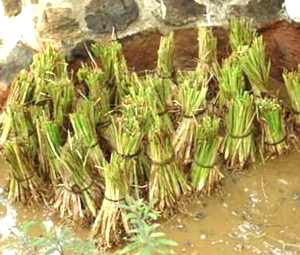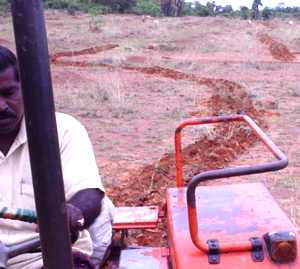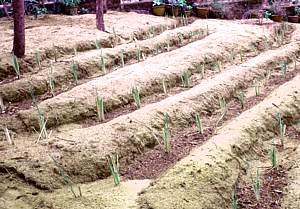The shoots and roots had been trimmed to about 8″ and 2″ respectively, and tied in bunches of 50 each. We untied each, to air the plants as they must have been stressed somewhat during travel.  After some airing and re-bundling, we set them in a slurry of cow-dung, immersing just the root portion. This Haridas, had said will keep them quite happy for say, about two weeks by when the rains were expected to arrive.
After some airing and re-bundling, we set them in a slurry of cow-dung, immersing just the root portion. This Haridas, had said will keep them quite happy for say, about two weeks by when the rains were expected to arrive.
Earlier on September 8, a group of us had marked a contour line at pointReturn using an A-frame [see link below]. This was about 400′ long. Haridas had recommended 2 vetiver tillers to be planted in a hole in a single row, with a spacing of 6″ between each. This would call for 1,600 tillers.  On September 15, local farmer and now friend, Babu Reddiar ploughed a furrow along the contour. The idea was to loosen the soil and clear it of weeds. Vetiver needs to be protected from weeds till it establishes itself. Loosened soil will soak up rains better.
On September 15, local farmer and now friend, Babu Reddiar ploughed a furrow along the contour. The idea was to loosen the soil and clear it of weeds. Vetiver needs to be protected from weeds till it establishes itself. Loosened soil will soak up rains better.
Then I waited for it to rain – and it simply would not happen! It was a lesson on the importance of timely rains in Indian agriculture. There are huge irrigation tanks in Jamin Endathur and Peruveli but they go dry by late summer. Farmers with wells irrigate with pumps. But for several hundred marginal farmers with small holdings, timely rains play a crucial role. Even those with power irrigation said, only a good downpour will let them plough the fields ready to be transplanted with paddy tillers grown in their nursery. So everyone waited looking at the sky.
By end September, when the rains were elusive, I decided to start the vetiver nursery at my farm, where irrigation is assured, Besides it was over two weeks of incubation in cow-dung slurry. The 3,000 tillers seemed to be thriving though. There were tender new white hairy roots and in an odd bunch, there were new tillers emerging.  A sloping part of the farm was marked for contours. About 1,000 tillers were planted at a 1′ spacing to allow for multiplication space.
A sloping part of the farm was marked for contours. About 1,000 tillers were planted at a 1′ spacing to allow for multiplication space.
Haridas felt the 2,000 continuing to stand in the cow-dung slurry would come to no harm. “After all, they are set on rafts or floats in ponds and sit there forever cleaning the water slowly,” he said. NE monsoons arrived on October 23. We picked Oct 27 to plant the vetiver at pointReturn – a good 6 weeks after their receipt from Kerala.
Chellamma, the lady who has worked in my farm for 14 years, two of her friends recruited for the day, Manoharan and I motored through driving rain, taking a longer and safer route to Peruveli. There we jumped into Babu’s tractor trailer [my car couldn’t make it on the slushy last leg] and arrived on the site at 11am.  We had packed our lunches and carried water and umbrellas. Soon the umbrellas were put away as they offered no protection in the steady, strong rain.
We had packed our lunches and carried water and umbrellas. Soon the umbrellas were put away as they offered no protection in the steady, strong rain.
By 1 am we were finished. Everyone giggling away, getting wet and enjoying the vast open spaces under rain. The first human deed to plant anything on the abandoned acres, now the pointReturn site, was done.
—
I’d rather not publish P Haridas’s phone number here. Instead, write to him at haridas.p@kdhptea.co.in giving your phone number and explaining what you are seeking. He may call you or write back – either way he will certainly respond if your need is well stated.
very educative articles, both of them. This information certainly is most
useful. Wonder, why it is not popular in this part of the country. I am tempted to get in touch with Haridas.
Very moving story, DV – thank you! Please keep us updated on the vetiver progress :)